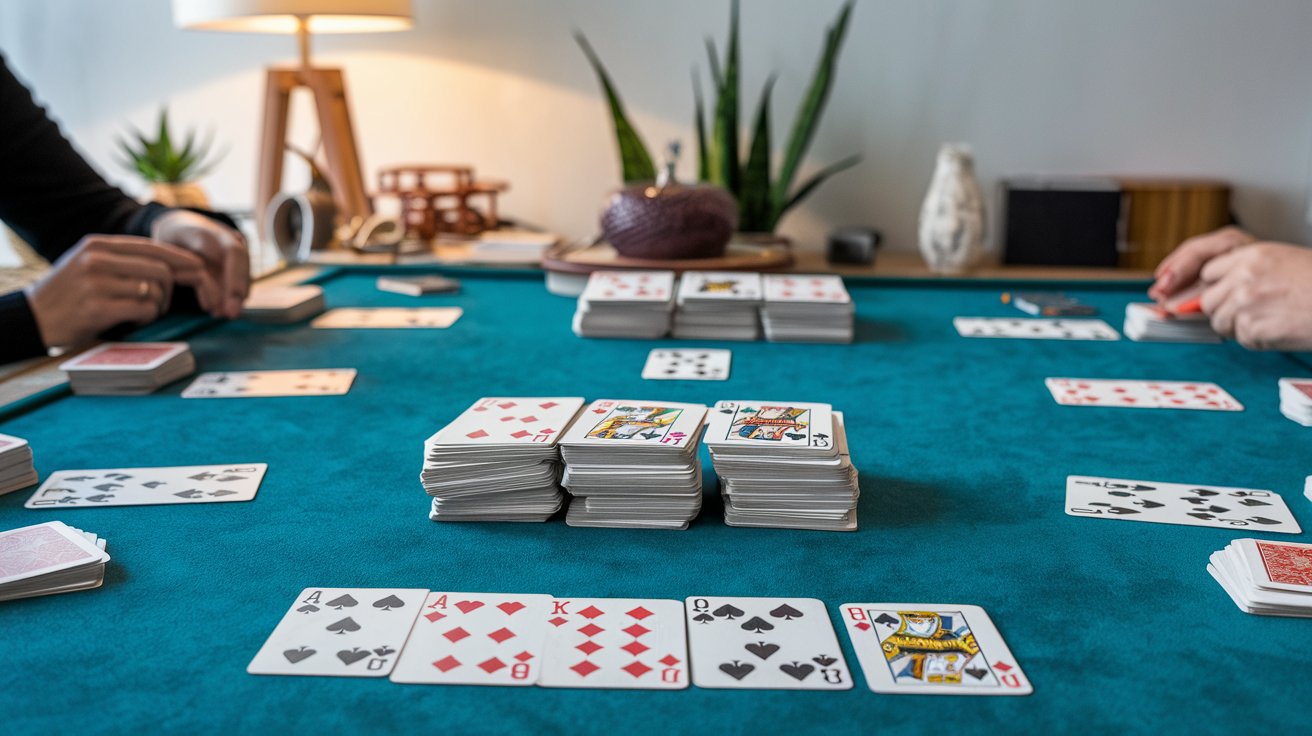In the world of card games, Rummy without jokers represents the purest form of the game—a true test of skill, strategy, and card sense. While joker variants have gained popularity for their added flexibility, traditional joker-free Rummy demands a deeper understanding of card relationships, greater memory skills, and more precise tactical planning. Whether you’re playing classic Gin Rummy, traditional Indian Rummy, or any other joker-free variant, mastering these games offers a particularly satisfying challenge.
In this comprehensive guide, we’ll explore expert strategies, advanced techniques, and tactical approaches that will transform your joker-free Rummy game from frustrating to formidable. By embracing these methods, you’ll develop the skills needed to excel even when faced with seemingly difficult hands.
Understanding the Foundations of Joker-Free Rummy
Before diving into advanced strategies, it’s essential to understand how the absence of jokers fundamentally changes the game’s dynamics.
The Strategic Landscape Without Jokers
In joker variants, these wildcards serve as universal substitutes, allowing players to easily complete sets and sequences. Without them:
- Every card becomes irreplaceable for its specific combinations
- Hand planning requires greater precision from the first draw
- Tracking discards becomes exponentially more important
- Card efficiency (maximizing the utility of each card) becomes paramount
This creates a more challenging but potentially more rewarding game where skill consistently outweighs luck over time.
Adjusting Your Mindset for Joker-Free Play

Success in joker-free Rummy begins with the right mental approach:
- Embrace patience as a strategic virtue
- View limitations as opportunities for creative problem-solving
- Accept that building a declaring hand typically takes longer
- Recognize that superior tracking and memory provide substantial advantages
This mindset shift will help you avoid the frustration many players experience when transitioning from joker variants to traditional play.
Essential Strategies for Winning Without Jokers
1. The Art of Hand Assessment
Without jokers to salvage difficult hands, initial assessment becomes crucial:
First-Round Priority Analysis
When receiving your initial cards, quickly categorize them into:
- Near-complete sequences (cards in numerical sequence of the same suit)
- Potential sequence connectors (cards that could connect existing sequences)
- Set-building cards (identical values across different suits)
- High-value disconnected cards (face cards with no clear path to melding)
This categorization should immediately inform your strategy, helping you decide which card groupings to pursue and which to abandon.
The “Connected Value” Principle
In joker-free Rummy, assess cards not just by their point value, but by their “connected value”—how many other cards in your hand they potentially link with. A 7♥ might be worth only 7 points, but if you hold 6♥, 8♥, 7♦, and 7♣, its connected value is extremely high.
Develop the habit of calculating this connected value when making discard decisions, particularly early in the game.
2. Strategic Card Grouping Approaches
How you conceptually group cards in your hand significantly impacts your success rate in joker-free games.
The “Core and Satellite” Method
Identify your strongest potential melds as your “core” and view other cards as “satellites” that either:
- Directly support your core (by potentially joining those melds)
- Offer independent melding potential
- Serve no strategic purpose and should be discarded
This hierarchical approach prevents the common mistake of pursuing too many partial combinations simultaneously.
The “Dual-Purpose Card” Strategy
Without jokers, cards that can potentially serve in multiple combinations become invaluable. For example, a 7♠ could potentially join either a 5-6-7♠ sequence or a 7-8-9♠ sequence.
Identify these versatile cards and prioritize keeping them unless absolutely necessary to discard. Their flexibility often proves decisive as the game evolves.
3. Discard Hierarchy in Joker-Free Play

Without jokers to mitigate mistakes, your discard decisions must follow a more rigorous hierarchy:
- High-point disconnected cards: Face cards and aces with no connection to potential melds
- Lower-point disconnected cards: Numerical cards that don’t connect to anything in your hand
- Duplicate cards that exceed meld requirements: Such as a fourth 8 when you already have three for a set
- Cards from your most challenging meld: When necessary to pivot your strategy
This hierarchy should be adjusted based on game progression—early game discards should prioritize disconnected high-value cards, while mid-game might require sacrificing cards from your least-developed combinations.
Advanced Tracking and Memory Techniques
Without jokers, the ability to track discards and remember card movements becomes a decisive competitive advantage.
1. Systematic Discard Tracking
Develop a methodical approach to tracking discards:
The Quadrant Method
Mentally divide the deck into four sections:
- High cards (face cards and aces)
- Middle-high cards (8s, 9s, 10s)
- Middle-low cards (5s, 6s, 7s)
- Low cards (2s, 3s, 4s)
For each quadrant, track specifically:
- Which suits have appeared frequently
- Which numerical sequences have been broken (e.g., if 6♥ and 8♥ are discarded, 7♥ becomes less valuable)
- Which sets have been disrupted (e.g., if two 9s are discarded, completing a set of 9s becomes harder)
This structured approach makes tracking manageable without overwhelming your working memory.
Progressive Probability Assessment
As the game progresses, continuously update your mental probability map:
- Cards you haven’t seen are either in the draw pile or opponents’ hands
- The more cards played, the more accurately you can estimate the likelihood of drawing needed cards
- Adjust your strategy based on these evolving probabilities
2. Opponent Pattern Recognition
Without jokers, opponents’ drawing and discarding patterns reveal much more about their hands:
- Notice which cards they pick from the discard pile
- Observe which suits they consistently discard
- Pay attention to hesitations before discards (often indicating difficult decisions)
- Track when their sorting behavior changes (often signaling strategy shifts)
These observations allow you to:
- Avoid discarding cards they likely need
- Estimate their progress toward declaration
- Adjust your own strategy based on their apparent goals
This competitive intelligence becomes far more valuable in joker-free games where each card matters significantly more.
Phase-Specific Tactics for Joker-Free Rummy

Different game phases require distinct tactical approaches in joker-free play.
Early Game (First 3-4 Rounds)
The Flexibility Foundation
In early rounds, prioritize:
- Discarding high-value disconnected cards immediately
- Maintaining maximum hand flexibility
- Establishing at least two strong potential meld directions
- Gathering information about opponents’ likely strategies
The Quick Assessment Technique
By the third round, conduct a rigorous hand assessment:
- Which combinations are developing most naturally?
- Which high-value cards should be protected vs. discarded?
- How does your progress compare to opponents’ apparent development?
This assessment should result in a clear strategic direction, allowing you to begin narrowing your focus.
Middle Game (Rounds 5-8)
The Commitment Phase
By mid-game, commit more definitely to specific combinations:
- Abandon marginal possibilities to focus resources on your strongest potential melds
- Begin tracking specific cards needed for completion
- Adjust picking strategy based on your highest priorities
The Defensive Calculation
As the middle game progresses, incorporate defensive considerations:
- Which cards are likely safe to discard?
- When should you hold cards defensively even if they don’t help your hand?
- Is someone approaching declaration, requiring you to minimize point exposure?
These defensive calculations become increasingly important as the game advances.
End Game (Rounds 9+)
The Declaration Decision Matrix
In the end game, continuously evaluate:
- The risk/reward of continuing to improve your hand versus declaring
- The likelihood of an opponent declaring before your next turn
- The point exposure if someone else declares first
The Final Card Efficiency Push
With declaration approaching, maximize card efficiency:
- Every card should directly contribute to a valid meld
- Maintain only the minimum unmelded cards required by game rules
- Consider strategic declaration even with a minimal qualifying hand if point exposure is high
Variant-Specific Strategies for Joker-Free Play
Different Rummy variants without jokers require specialized approaches.
Gin Rummy Specialized Tactics
In classic Gin Rummy:
- The “knock” decision becomes more strategic (declaring with unmatched cards below a point threshold)
- “Gin” (having all cards in valid combinations) carries a premium
- Defensive play—preventing opponents from completing combinations—gains importance
Specific Gin Rummy strategies include:
- The “Early Knock” approach for hands with quick organization potential
- The “Gin Hunt” for hands with multiple near-complete melds
- The “Defensive Hold” when you suspect an opponent is near completion
Traditional Indian Rummy Without Jokers
In Indian Rummy without jokers:
- The pure sequence requirement (a sequence without substitutions) remains
- Managing point exposure becomes even more critical
- Drop decisions (choosing to fold for a predetermined penalty) require precise calculation
Key strategies include:
- First-drop analysis (folding immediately with poor hands)
- The “Rapid Pure Sequence” approach focusing on quickly meeting the minimum requirement
- The “Point Minimization” strategy when catching up seems unlikely
The Mathematics of Joker-Free Rummy
Understanding the mathematical principles underlying joker-free Rummy provides substantial advantages.
Probability-Based Decision Making
Without jokers, probability calculations become more straightforward:
- Each card has a 1/52 chance of being drawn initially (minus those already visible)
- The probability of drawing a specific card increases as the deck thins
- The “Rule of 4” reminds you there are only four of any given rank in the deck
Use these probabilities to make strategic decisions:
- If you need one specific card (like the 4♥) to complete a sequence, your odds start at roughly 8% per draw
- If you need any of several cards (like any 4 for a set), your odds improve significantly
- As you track discards, continuously update these probabilities
Expected Value Calculations
Each decision in joker-free Rummy has an expected value—the average outcome accounting for all possibilities:
- Higher expected value plays prioritize cards with multiple potential uses
- Lower expected value plays include holding out for specific cards already heavily discarded
- The expected value of a drop decision depends on your current point exposure and drop penalty
Though you won’t calculate these values explicitly during play, understanding expected value concepts guides better intuitive decisions.
Psychology and Table Presence in Joker-Free Rummy
Without jokers to bail players out, psychological elements gain prominence in Rummy.
Projecting Strategic Confidence
How you present yourself at the table impacts opponents’ decisions:
- Maintain consistent timing even when receiving good or bad cards
- Organize your cards methodically regardless of their quality
- Control reactions to both fortunate and unfortunate draws
This consistency prevents opponents from gaining psychological advantages even when your cards are poor.
Reading Opponents in Joker-Free Games
Without jokers, opponents’ reactions reveal more specific information:
- Excitement when drawing often indicates a specific needed card rather than a versatile joker
- Frustrated discards often reveal which specific combinations they’re pursuing
- The rhythm of their sorting after draws indicates whether cards fit their strategy
These psychological reads provide actionable intelligence in planning your moves.
Common Mistakes in Joker-Free Rummy
Avoid these frequent errors that undermine success in traditional Rummy:
Overcommitment to Initial Patterns
Many players stubbornly pursue the combinations visible in their initial hand, even when draws don’t support them. Instead:
- Remain flexible through the early game
- Be willing to pivot strategies based on what you draw
- Abandon even promising combinations if they become too difficult to complete
Neglecting Set Possibilities
Without jokers, players often focus exclusively on sequences. Remember that:
- Sets (three or four cards of the same rank in different suits) remain valuable
- Sets often require less specific cards than sequences
- A balanced approach pursuing both sets and sequences maximizes flexibility
Defensive Discard Errors
Without jokers making combinations easier, discarding safely becomes more complex:
- Avoid assuming cards are safe to discard simply because you don’t need them
- Consider which cards connect to those you’ve seen discarded
- Be particularly cautious discarding sequential cards (6s, 7s, 8s) which often form the core of sequences
Conclusion: Mastering the Pure Form of Rummy
Playing Rummy without jokers represents card gaming in its most strategic form. While initially more challenging, the skills developed—precise tracking, probability assessment, strategic flexibility, and psychological awareness—create a more rewarding experience where skill consistently prevails over luck.
By implementing the strategies outlined in this guide, you’ll transform your approach to joker-free Rummy, developing the capacity to excel even with challenging hands. Remember that mastery comes through practice—each game provides new opportunities to refine your tracking abilities, strategic assessment, and tactical execution.
Embrace the challenge of joker-free play, and you’ll discover a deeper, more satisfying Rummy experience where your growing expertise becomes clearly evident in your results. The pure form of Rummy might demand more, but for serious players, it offers the ultimate test of card gaming prowess—and the most meaningful victories.

Zareb Saleh is a journalist at Gulf Today and a ghostwriter for Gameoholic, specializing in gaming, technology, and digital culture. With a keen eye for industry trends, he delivers insightful stories that engage and inform readers.




